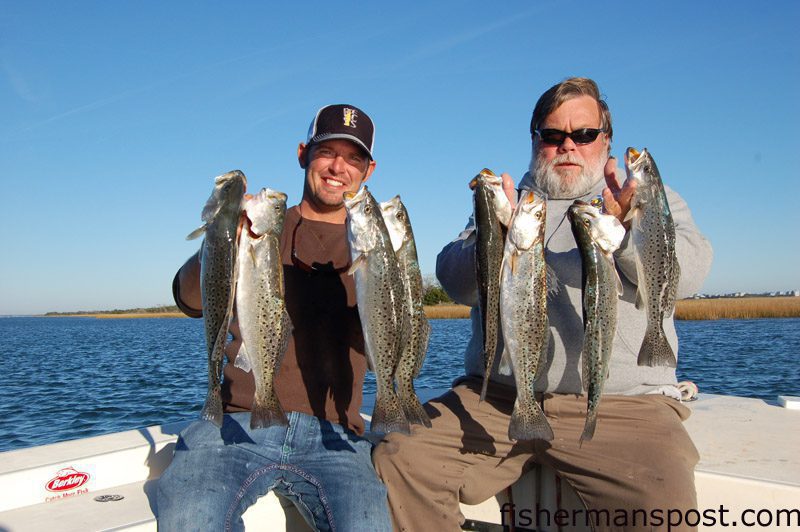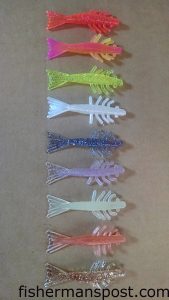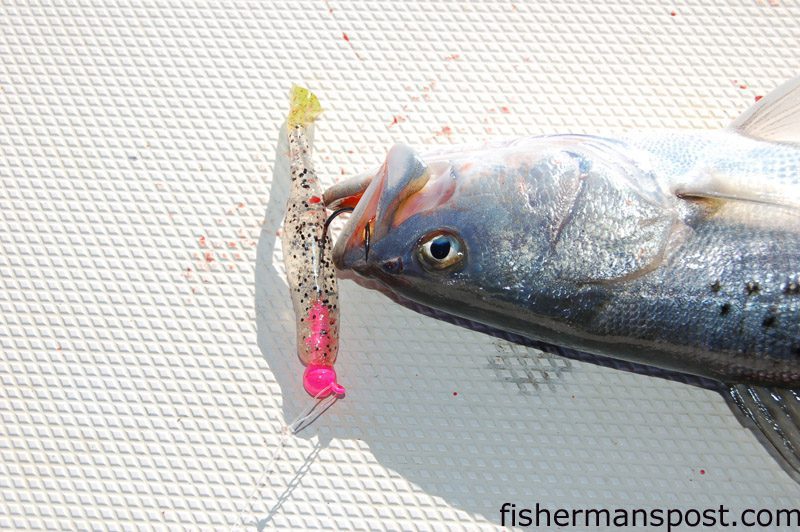Guide Time – Trout in a Candy Store

Capt. Wayne Crisco, of Last Resort Charters, and Capt. Jodie Gay, of Blue Water Candy Lures, with two limits of 18-20″ speckled trout that fell for Back Water Candy soft plastics and live shrimp at some ICW structure south of Surf City.
“What’s that…32?” I queried the anglers at the back of the boat as I swung the 13” speckled trout over the bay boat’s gunnel.
“Nope, Wayne just had 32 and I had 33,” Fisherman’s Post Sales Manager Joshua Alexander corrected. “That’s 34.”
The trout were flying in (and out) of Capt. Wayne Crisco’s boat faster than they could be counted, as we’d been fishing just 10 minutes and I was already consistently forgetting our total.
“They’re not hitting this one like that,” Capt. Jodie Gay, of Blue Water Candy Lures said, holding one of his brand new soft plastic baits on a red jighead as he looked at the similar combo I was removing from number 34’s mouth. “Pink head and chartreuse tail, huh? I haven’t tried that one. This Opening Night Paddle Tail was the ticket when Connor and I were here.”
For Jodie, the lure maker, this qualifies as research and development, and his last such outing had been with his 7-year-old grandson earlier in the week, a trip that had produced 104 speckled trout, the majority caught by the junior angler.
“Can you imagine how much fun this is for a kid?” Jodie continued as he quickly swapped his soft plastic for one closer to the color I was tossing. “That’s why we invited Josh,” he added with a grin as the salesman snapped his rodtip back to the head-shaking protest of another little trout.
“41!” Joshua called as he slid the fish back overboard.
Jodie, a longtime commercial fisherman whose Blue Water Candy line of offshore lures took over his attentions more than a decade ago, introduced his first line of inshore lures earlier in 2014. The Paddle Tail, Swirl Tail, and Shrimp soft bodies match well with the jigheads he’s been making for the backwater market for several years, and Jodie had paired up with Wayne, an inshore specialist who runs Last Resort Charters out of the Surf City area, for further testing and research on this late November day.
A pink Cross-Eyed Ball head with a Salt & Pepper/Chartreuse Paddle Tail continued to produce for me, and I had to change it out after fish #53, at least the 20th to have fallen for the combo since we’d pulled up at a shallow cove along a grass bank leading to New Topsail Inlet. No fool, I went for another of the same after my grub became too torn to secure back onto the jighead’s collar.
Though Wayne still falls well under middle-aged, he’s a traditionalist who grew up on these waters and tends to focus on old-school techniques that produce results over the latest and greatest (usually more of the former than the latter) products on the market. Particularly for clients who have little to no background in inshore fishing, the captain’s simple, tried-and-true philosophy puts fish in the boat and smiles on faces—and for speckled trout, that means live shrimp.
Not always available and consistently expensive when they are, live shrimp are practically Kryptonite to cool-weather speckled trout, and our day started by securing a livewell full to augment the mountain of soft plastics and jigheads Jodie had brought aboard.
Prior to our numbers game near Topsail Inlet, we’d pulled into an area of docks off the ICW where Wayne had had plenty of recent success on larger trout.
“Y’all like my tackle bag?” Jodie had asked with a grin as Wayne slid the anchor overboard.
A giant zip-lock bulging with dozens of individual bags of the Back Water Candy soft baits and After Shock and X-Eyed Ball jigheads had materialized on Wayne’s leaning post, and Joshua and I wasted no time digging into the myriad of colors and styles.
A Shrimp body in the Opening Night color spoke to me, particularly since Wayne had been catching fish on shrimp lately, and I threaded it onto an unpainted X-Eyed Ball jig.
Wayne doled out a few instructions as I fired my first cast.
“Most of the fish have been sitting near where that dock meets that bulkhead,” he explained, pointing a spinning rod behind the boat. “Cast out front and all around, too, though. It seems like they just kind of mill around in a big circle here and they could be anywhere.”
Sharing the back of the boat with Wayne, I’d begun a twitch/twitch/pause retrieve on my third cast when an authoritative thump interrupted the rhythm.
I answered with a much sharper snap of the rod and felt weight and a thrashy head shake in response.
“Believe that’s a trout,” I said through a widening smile.
My blue braided line began angling upward through the clear green water, and seconds later the speck was tossing water back and forth as it shook its head on the surface in an attempt to dislodge the hook.
Net in hand, Wayne stepped between me and the transom as the fish grew closer. With a quick scoop from the captain, our first fish of the day and my first on a Back Water Candy bait lay behind the leaning post, its back shining iridescent purple in the late-morning sunlight.
“He wanted that thing, Jodie,” I said after scooping up the fish for a photo and opening its mouth to reveal it had entirely engulfed the 4” bait and jighead.
“Yeah, they like that shrimp. We were crushing them on the Carolina Bug color last week,” Jodie replied. “Watch how it sinks. I worked on that design until we got the legs to wiggle while it sinks.”
Letting the shrimp descend into the clear water beneath the hull, the legs indeed wobbled enticingly as the lure fell, action that tempts aloof fish to bite and slows the lure’s fall, keeping it in the strike zone as long as possible.
A solid 18” keeper, the trout was soon finning in Wayne’s livewell after we snapped a few photos and resumed casting.
Joshua was next to strike, proving both Wayne’s earlier theory of trout movement and the effectiveness of the Swirl Tail as he set the hook after a cast off the bow. After we disentangled it from the mesh of Wayne’s outsized net, the Pearl Swirl Tail proved to be just as deeply entrenched in the jaw of another 18” speck, a quality fish although dwarfed by the substantial frame of the angler that hooked it.
“I need to get some smaller anglers,” Wayne chuckled, after that fish, too, made its way into his livewell. “Y’all make the fish look little.”
A fellow Big & Tall shopper, Jodie didn’t do our next fish any favors in pictures either, but he did prove that the Paddle Tails were no slouches, either, connecting with a cookie cutter to our fish on one of the Back Water Candies in the Sparkle Ice hue.
Apparently not content with just the speck, he invited a puppy drum to our photo shoot a few casts later, well below the size limit but equally unable to turn down the Sparkle Ice.
I’d noticed some slight bumps from pinfish or other diminutives on several casts, fairly unusual with unscented plastics, and then saw a sticker on one of the bags as I changed things up for a Paddle Tail that forced a question.
“Sweet Tea Scented? These are sweet tea scented? That works?” I queried Jodie while threading on an Albino Shad paddletail.
“Not exactly,” came his reply through a hearty laugh. “We worked up a scent that’s effective, but we all think it smells nasty. One lady who works for us said it smelled like sweet tea, so we told her she can do all scent—she doesn’t like it as much anymore.”
The pinfish bumps continued, but we all made a dozen or so more casts without putting a fish in the boat, testaments that either the fish had moved on in one of their circuits of the area or the bite had slowed.
Eager to see what a live shrimp would do after the artificial bite slowed, Wayne had soon pinned one of the flicking “bugs” onto a slip float rig set to suspend the offering just above the bottom.
Casting into the corner between dock and bulkhead where we’d hooked our first fish, the float had barely settled from splashdown before it disappeared below the surface.
Wayne picked up the slack with the reel, lifting the rod to a healthy bend and, quickly thereafter, the fluttering tip that telegraphed a speckled trout was likely at the other end. Manning the net for his own fish when the time came, the captain quickly laid our largest fish so far on the fiberglass, a porky speck pushing 20” that found a live shrimp suspended in its face simply irresistible.
This fish, too, became the subject of a short modeling session before joining its companions in the livewell.
Passing the rod to Joshua, Wayne fished a new shrimp from the livewell, pinned a treble hook just under the horn on its head, and instructed the angler to cast in the same vicinity. Again, the bright orange and yellow cork bobbed only momentarily before ducking underwater, but Josh met no resistance when he cranked in the slack line and raised his rod tip.
“Probably a black drum,” Wayne explained, replacing the shrimp after the salesman reeled in an empty hook. “There are a bunch of small ones in here.”
Joshua’s next cast proved Wayne correct again, and a black drum just under the new NC’s 14” minimum size limit put up a bit of a tussle before it was the next to meet the net.
The cycle continued unabated for nearly half-an-hour: shrimp meets hook, float hits water, float disappears, Joshua reels in a fish or an empty hook. There were more black drum (several over the size limit), more puppies (none anywhere close to their 18” minimum), and several more 18-20” specks. For the Sales Manager, who’d never drifted shrimp before, it was nonstop action that led to a bevy of additions to the livewell. We drifted a few shrimp off the bow and continued working the plastics, but Joshua clearly had the hot corner and we were content to let him enjoy it.
Even the shrimp bite eventually tapered off, however, and Wayne decided it was time for a move.
“Seems like it shut down in here,” he thought out loud after his three anglers made three more biteless casts. “The tide’s slowing down and it probably won’t turn on until it starts falling. How about we go down and kill some time at the south end until it switches?”
Jodie had already told us of the nonstop bite he’d enjoyed with his grandson a few days before, so no one had any complaints about seeing if the steady fishing continued, regardless of how big the fish were.
A quick run to the south had Wayne tossing anchor next to an oyster bar extending from a slight depression in the bank of a creek connecting to Topsail Inlet.
“We were catching them all around here,” Jodie said. “It’s perfect for a kid because you don’t even really have to cast—we were catching them right beside the boat.”
Joshua and I were the first to fire our jighead/Back Water Candy combos, and the fish were apparently still in the same form as we both hooked up on our initial casts.
We’d made our casts upcurrent and towards the bank, but Jody and Wayne took the opposite side of the boat and real estate, casting downcurrent and toward the creek’s winding channel.
Both strategies proved effective, as Jodie and our captain had both connected by the time I’d photographed my jig hanging from the lip of my 14.5” fish, our first fish and first (and last) keeper at the spot.
Joshua had chosen the Pearl Swirl Tail for his X-Eyed Ball jighead, and while all of us were hooking up on more casts than not, his grub and the Salt & Pepper/Chartreuse I’d picked were producing noticeably more fish than the Opening Night and Albino Shad patterns that the professionals were working. Either the upcurrent cast or the colors were producing a bit more action, and I found that even if a fish shook the hook on the way to the boat, I’d nearly always get bit again before I’d reeled the lure back. One spike even gave my Paddle Tail a resounding thump as I held the line in my hand to pick out a wind knot on my reel.
Jodie and Wayne were quick to notice the difference in our catch rates, and they changed grubs and casting angles, leading to near constant multiple hookups and more than one time all four rods trembled from the headshakes of the little specks.
Inside of 30 minutes, we were counting down to the triple digits, and decided to check out another spot in a nearby creek once we’d released our hundredth fish.
The high-volume catch-and-release action made keeping an accurate count tough, but we stayed conservative on the numbers, ensuring that we had an honest hundred before creek-hopping a half-mile further south. Live shrimp would have surely produced plenty of action with the little trout as well, but the headache of constant re-baiting, significantly higher odds of deep-hooking undersized fish, and the idea of losing a 50 cent bait on each cast made it a silly proposition in terms of both efficiency and economics.
Unable to resist a guaranteed bite, Joshua and I made a few more casts while Wayne packed up and pulled anchor, landing specks 102 and 103 at the spot by the time he put the motor in gear.
Spike trout were looking for meals at this next spot as well, but either not as hungrily or in significantly smaller numbers. We all put a few fish in the boat, but in the time it took us to put up triple-digit numbers at our previous spot, we’d caught and released perhaps 10 here.
Though the tide was still trickling in, Wayne thought the bite would be turning back on at his dock spot after our hour-long hiatus, and we were soon pulling anchor for another brief run north.
Joshua and Wayne each grabbed a slip-float rig as the boat swung around on the anchor, while Jodie and I stuck with the soft plastics. Remembering the Shrimp’s fluttering legs on the fall, I went with what seemed to be Jodie’s favorite color in the style—Carolina Bug. Large red and gold glitter flakes in a translucent soft plastic, the bait offered a very convincing facsimile of the real thing. He chose a paddle tail, and the four of us began casting in the hunt for a few more of the larger specks before we made for the boat ramp in the waning afternoon light.
The tide was still nearly stagnant, and as Wayne predicted, the bite wasn’t nearly as lively as it had been in the morning.
“The tide just won’t turn today,” he lamented after a few minutes without a bite. “They’re not really going to start eating until it’s moving out.”
Despite the slower fishing, we did manage to add several more specks to the livewell (including a 21” fish) on both the plastics and the shrimp over the next hour. Several more of the black drum also found Joshua and Wayne’s shrimp irresistible, and we added a pair of the porky, striped fish that made the 14” cut to our haul for the table as well.
With the sun dropping, family obligations for Wayne, and a date with the Fisherman’s Post office in my immediate future, we headed for the ramp with an even dozen specks (my 14.5” fish the only one under 17”) and four black drum to take home along with at least 150 released (counting specks, black drum, puppy drum, and a 5” flounder that somehow got the Carolina Bug in its mouth), a stellar combination of action and quality in my book.
In addition to trout, Wayne targets flounder and red drum from New River to Southport, along with a variety of nearshore targets in the ocean, and he knows how to connect seasoned veterans and saltwater virgins alike with both steady fishing and rewarding time on the water. Check out his website at www.lastresortcharters.com or give him a call at (910) 465-0611 to talk about a charter.
And anglers can check out Blue Water Candy’s Back Water Candy line of jigheads and soft plastics at local tackle shops or visit www.bluewatercandylures.com to learn more.


